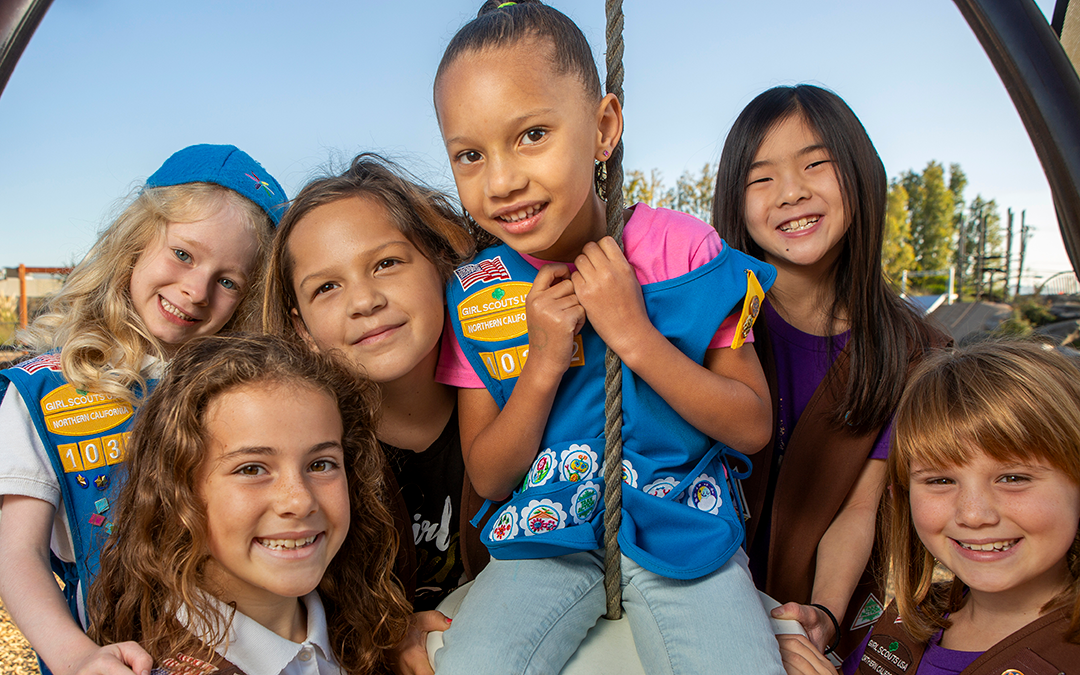Girl Scouts is a place of growth and safety for all girls—no matter their race, religion, ability, gender identity, or sexuality. In a contentious world, this is easier said than done. So how do we, as volunteers, create a space where any girl can thrive and feel supported as her whole self?
Save it for later!
“Now more than ever, we have to stand together as one people, one nation—regardless of our opinions, race, religion or beliefs, gender, who we love, what language we speak, or where we come from,” says Girl Scouts’ developmental psychologist, Dr. Andrea Bastiani Archibald. “But unity doesn’t mean abandoning the things that make us different from one another, and it doesn’t mean standing by or looking the other way in the face of bigotry and hatred. Real unity is what you get when a lot of very diverse people come together to form one complex yet seamless whole. It’s about equality, inclusiveness, and dignity—values I think we as parents all hope to instill in our children.”
But creating an atmosphere of inclusion in your troop isn’t a one-size fits all solution. Some troops are made of up girls with similar backgrounds and identities, and others are very diverse; both types of troops have unique problems to solve, and ways they can better understand and promote inclusivity. Here are our five best tips and strategies to help your troop truly be a sister to every Girl Scout:
Hit the Books
Whether you just started a troop or have been volunteering for a decade, you know that the first step to helping your girls learn and grow is to learn and grow yourself. Volunteers are role models in their girls’ lives, and they look to you for guidance on how to grow up to be a good person. The first step is learning more about people different from you.
Whether you’ve experienced feelings of exclusion or judgment based on what you look like, where you come from, or what you believe, or you’ve always felt welcome in your community, you can always learn more about what it’s like to walk in someone else’s shoes. Attend seminars on diversity, read books by authors of different races, faiths, and backgrounds than you, and think about what privileges you have (ways in which your identity makes life simpler for you) and don’t have.
Most importantly, talk to new people! Listen attentively, believe their stories even when they are different from your understanding of the world, and make sure they feel welcome in your community. Invite parents to participate in troop activities or bring your new neighbor a baked good—it’s about being a good listener and reaching out in kindness. The wider your understanding of different experiences is, the more you can show your girls how to practice empathy and make everyone feel welcome.
Pro Tip: Not sure where to start learning? This reading list can get you started on all sorts of diversity topics!
Tolerance is not Enough
Teaching girls about tolerance sounds great in practice, but what does it mean to simply tolerate someone different from you? Girl Scouts’ Developmental Psychologist, Dr. Andrea Bastiani Archibald, breaks it down for us: “When we use the word ‘tolerance’ and teach kids to tolerate those who are different from themselves—whether in skin color, nationality, their belief system, the language they speak, how they choose to dress or represent themselves, their physical abilities, sexual orientation, or body shape and size—we’re reinforcing differences and implying that those people are somehow beneath or worth less than others, but that we need to ‘put up with them’ anyway.”
Instead of approaching diversity from an attitude of ‘putting up with differences’, help your girls understand the message of diversity hidden in the Girl Scout Law— “being a sister to every Girl Scout.” Encourage the girls in your troop to invite a new girl to a troop meeting, to sit with anyone at lunch that’s eating alone, and to stand up for each other and other girls who might need support. Making new friends with girls from across your community is a perfect way to trade tolerance for inclusivity.
Pro tip: Dr. Archibald really knows her stuff—check out her other advice about talking to girls about inclusion.
Don’t Avoid the Issues
As much as we try to protect our girls from the scarier things going on in the world, it’s impossible to shield them from the many difficult, confusing, and sometimes upsetting conversations and events happening around us. It’s tempting when we see serious topics like racism, free speech, xenophobia, or sexism in the news to just avoid having a conversation with your girls. But if these topics stress you out, imagine how your girls must feel about them with even less knowledge and experience! Girl Scouts, no matter their age, live in the real world, and they need to be prepared to deal with the serious and important topics that adults deal with. And that means having a lot of good but hard conversations.
Find out what worries them, whether it’s feeling like the boys in their class get called on more, or issues of war and political strife. Listen to their feelings, and discuss the issue as a group in an age-appropriate way. Taking their ideas and feelings seriously shows girls that their opinions and emotions matter, which will help give them the courage to stand up for their beliefs, ask critical questions, and build character.
Tell your girls that it’s ok and understandable to feel afraid, anxious, or sad when faced with scary circumstances or hateful, exclusionary ideas, and that they shouldn’t feel embarrassed to share them with the people she loves. Giving girls space to talk about subjects they find scary or confusing helps them feel safer and more supported in their lives, and more likely to talk to a trusted adult like you when they need help or are facing new conflicts.
Pro Tip: Keep having these conversations: the more you talk to your girls about what’s important to them in supporting diversity and fighting against hate, the more prepared they’ll be for a future of leadership.
Think Critically
You’re focusing on friendship, you’re learning new things, you’re talking to your girls about important real-life topics—so how can you (and they) make sure you’re getting the real story? The world is full of ideas and opinions that get treated as facts. From fake news to stereotypes, it can feel like a minefield of information to navigate. You may know that someone on Facebook isn’t a good source of information, but do your girls know that? A girl’s best weapon against misinformation is her brain!
When she comes across information that is new, or information that disagrees with what she knew before, help her to learn to ask questions: Is this real or true? How does she know? What does she know about the person or organization making the claim? Do they have an agenda, or a stake in making you believe this is true? If it’s a media company or online news source, has she ever heard of it before? If it’s a person she knows, a celebrity, or a public figure, are they known for being honest and fair—or do they have a track record of sometimes exaggerating facts? What makes them an expert on this subject? Why would they know better than someone else? Is that statement true for everyone in that group of people? Asking for more information isn’t disrespectful, it shows that she’s paying attention and curious to learn more!
Pro Tip: Avoiding fake news can feel like a fulltime job! Here are some more great tips on helping your girls think critically.
Practice Speaking Up and Speaking Out
Being a sister to every Girl Scout sometimes means standing up for yourself or someone else. Whether it’s telling a classmate to stop being a bully, or having an argument about a topic that’s important to her, standing up for what she believes in can be a scary experience. The best way to make a scary activity less scary? Practice!
In your discussions, girls might have disagreements about what they think. Help them engage in these moments by teaching them to listen actively. “If someone else is speaking, give them the courtesy of listening to and thinking about what they’ve said before responding, forming your own opinions, or dismissing theirs,” advises GSUSA on their parenting blog, “Raising Awesome Girls.” “Your girl may not agree with what’s being said, and that’s absolutely OK (and sometimes important!) for her to express, but she should wait her turn, pay attention, and avoid jumping to conclusions. You never know, what someone says could surprise her!”
Talk about other situations they might encounter and the way they could feel about those situations. It might feel safer for them to go with the crowd or agree with her friends when someone does something wrong, but that’s not fair or right. “Talk to your girl about weighing the pros and cons of the choices she makes in her daily life, about thinking about what’s right, and what will lead to the best outcomes for all involved.” It takes courage to stand up and support a less popular opinion, but it’s worth it to the right thing.
Remind them that if they feel scared or alone at the prospect of standing up to challenge injustice, it’s likely that lots of other girls do too! It only takes one person to change the dynamic, and help others find their courage to stand up for what’s right alongside you!
Pro Tip: Speaking out against injustice is an amazing way to help your girls embrace their own confidence, courage, and character. Try these strategies to support them as they practice their bravery.
With these strategies, you have a full toolbox to make your troop a more inclusive one, full of girls brave and kind enough to stand up for what they believe in. Have you had any important discussions with your girls, or seen them take a stand against injustice? Let us know in the comments!
What to do next:
- Our program partner, Annie Fox, offers programs that teach girls how to navigate the ins and outs of friendships. Strengthen your girl’s community-building skills with Annie Fox classes.
- Read how Kristine’s Cadettes addressed the difficult issues of inequality they saw on the news and learned how to discuss them in their troop meetings.

Katie Mock—Katie is the Marketing Copywriter for the Girl Scouts of Northern California, where she writes everything from tweets to Trailhead articles, and makes sure everyone dots their ‘i’s and crosses their ‘t’s. Although she was a Girl Scout for only a few years, her experiences with Girl Scouts, combined with attending a single-sex high school, gave her a profound appreciation for the power all-girl spaces have to change girls’ lives for the better. Katie moved to the Bay Area after graduating from the University of Chicago with a B.A. in Linguistics; when she’s not diving into writing with a red pen, you can find her geeking out about the latest sci-fi novel, cooking anything from traditional Japanese Cuisine to pizza, or cuddling her two cats.



K. Sumi’s piece at the end was such a great addition to your already terrific article.
Glad that you feel the same way as us 🙂